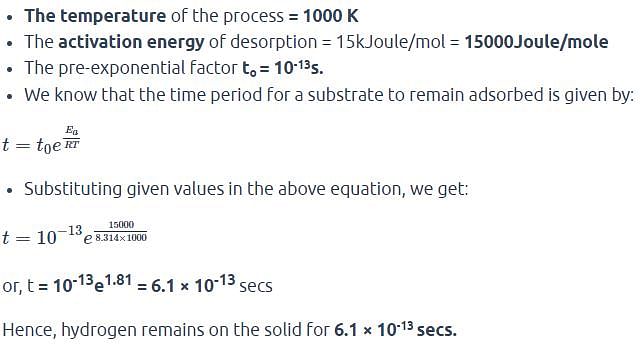Adsorption, Surface Chemistry - Chemistry MCQ
20 Questions MCQ Test - Adsorption, Surface Chemistry
Calculate in multiples of 10-13 how long a hydrogen atom will remain on the surface of a solid at 1000 K if the desorption activation energy is 15kJoule/mol. Assume that τ0=10−13 s.
The volume of gases NH3, CO2 and H2 gas adsorbed by 1 gm charcoal at 300 K lie in the order ?
| 1 Crore+ students have signed up on EduRev. Have you? Download the App |
The adsorption of a gas an a solid surface was found to follow a langmuir isotherm with K = 4 Pa-1 at a temp of 25 °C. The pressure of a gas required to achieve a fractional surface coverage of 90 % is _____________________________ (in Pa), (upto two decimal places)
Which of the following factor's influencing the adsorption?
Following plot represents the varition of temperature T with pressure for a definite extent of adsorption (xin) is called

Which among the following statements are NOT collects w.r.t. adsorption of gases on a solid ?
Graph between log (x in) and log (P) is straight line at angle of 45° with intercept is 0.602 ?

The extent of adsorption (x in) at a pressure of 1 atm is
Which of the following animation 's are correct in which B .E .T equation reduced into Langmuir ?
Which of the inherent assumption in the Langmuir model of surface adsorption are ?
Following is the varition of physical as adsoiption with temperature ?
Which of the following plot does not corresponds to the adsorption isotherm ?
The adsorption of a gas is described by the L angmuir adsorption isotherm with K = 0.3 kPa-1. A t a pressure of 0.2 kPa. the if actional coverage is
At 273 K, N2 is absorbed on a niica surface. A plot of  ( V in m3 and P in torr) gives a straight line with a slope equal to 2x 10-5 torr m-3 and intercept equivalent to Vm is equal to 4 x 10-8 m3. The ad solution coefficient is _____________________ x 1012 (torr-1) ( upto two decimal places)
( V in m3 and P in torr) gives a straight line with a slope equal to 2x 10-5 torr m-3 and intercept equivalent to Vm is equal to 4 x 10-8 m3. The ad solution coefficient is _____________________ x 1012 (torr-1) ( upto two decimal places)
At 273 K, H2 is absorbed on a mica surface. A plot of  vs P (V in m3 and P in Pa) gives a straight line with a slope equal to 2 cm-3 and intercept is 3x10-3 cm-3 Pa respectively. The adsorption coefficient is ____________________ x 103 Pa. (upto two decimal places)
vs P (V in m3 and P in Pa) gives a straight line with a slope equal to 2 cm-3 and intercept is 3x10-3 cm-3 Pa respectively. The adsorption coefficient is ____________________ x 103 Pa. (upto two decimal places)
Calculate the adsorption of a dye on activated carbon at 25°C, where k = 0.025, n = 0.5 and C = 0.04.
Based on the Freundlich isotherm.
The time for which the oxygen atom remains adsorbed on a tungsten surface is 0.36 at 2550 K and 3.49 at 2360 K. Calculate the activation energy of desorption of oxygen atom.
Ail organic fatty acid forms a surface film on water that obeys the two-Dimensional ideal gas law. If the surface tension lowering is 10 mNm-1 at 25°C. The surface area per adsorbed molecules is
An 18°C . the surface tension (γ) of an aqueous solution of butyric acid is represented by the equation γ = γ0 -29 .8 log( 19.64 c2 + 1 ) where γ0 is surface tension of water is 0.0073 Nm-1 and c2 is the bulk concentration of the solute. Using the Gibbs adsorption isotherm to estimate the surface excess of butyric acid at c2 is equal to 0.01 mol dm-3
The number of molecules of CETANOL absorbate of cross-section area 2.58 x 10-19 m2 can be observed on the surface of a spherical drop of dodecane of radius 17 .8 pm is ________________ x 104. (Round off to two decimal places)













































